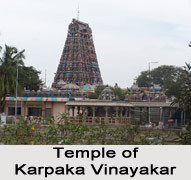 The image here is rock cut. The Karpaka Vinayakar Shrine is one of the oldest cave temples. The town of Pillaiyarpatti is named after `Pillayar` - the Tamil name for Ganesha, and this temple houses images of Shiva, Lingodbhavar and others.
The image here is rock cut. The Karpaka Vinayakar Shrine is one of the oldest cave temples. The town of Pillaiyarpatti is named after `Pillayar` - the Tamil name for Ganesha, and this temple houses images of Shiva, Lingodbhavar and others.
Deity: Karpaka Vinayakar or Desi Vinayaka Pillaiyar is the presiding deity and he is shown here with two arms and a trunk curled towards his right in the valampuri mode. This six feet tall image is in bas-relief in an excavated cave, close to the temple. Tiruveesar is Shiva lingam carved in a similar manner. Other deities include Marudankudi Eesar and his consort Vaadaamalar Mangai.
Antiquity: Over 15 inscriptions are found in the temple, that gives the age of the temple. The Stalapuranam states that this temple was built in three stages. The first stage goes back 1600 years. During this period, the innermost shrines came into being. The image of Ganesha gives this date; the characters used in the temple inscriptions also help establish this date. The pillars in the shrine are of pre-Pallava origin. The inscriptions at Pillayarpatti date back to the 4th century AD. There are several inscriptions within this temple that date it back to 1091 AD and 1238 AD, stating that the Pillayarpatti Nagarattar became the custodians of the temple during the 13th century. During the second growth the temple the vimanas and Rajagopurams were built.
The third phase saw the repair, rebuilding and refurbishment of the entire temple complex, including the renovation of the temple tank. The tank and two Raja Gopurams provide an attractive approach to the temple.
Festivals: The grandest of festivals is Ganesh Chaturti in the month of Aug - September, where a ten-day celebration brings much gaiety to this temple town.





















